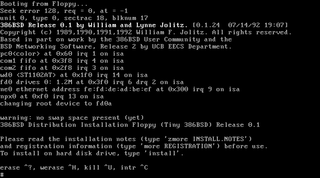 W
W386BSD is a discontinued Unix-like operating system based on the Berkeley Software Distribution (BSD). It was released in 1992 and ran on PC-compatible computer systems based on the 32-bit Intel 80386 microprocessor. 386BSD innovations included role-based security, ring buffers, self-ordered configuration and modular kernel design.
 W
WApache Mynewt is a modular real-time operating system for connected Internet of things (IoT) devices that must operate for long times under power, memory, and storage constraints. It is free and open-source software incubating under the Apache Software Foundation, with source code distributed under the Apache License 2.0, a permissive license that is conducive to commercial adoption of open-source software.
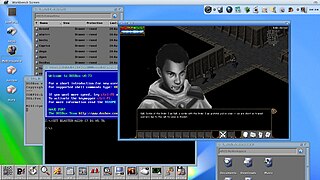 W
WAROS Research Operating System is a free and open-source multi media centric implementation of the AmigaOS 3.1 APIs. Designed to be portable and flexible, ports are currently available for x86-based and PowerPC-based PCs in native and hosted flavors, with other architectures in development. AROS, in a show of full circle, was also ported to the m68k-based Amiga 1200, and there is also an ARM port for the Raspberry Pi series.
 W
WAsteroidOS is an open source operating system designed for smartwatches. It is available as a firmware replacement for some Android Wear devices. The motto for the AsteroidOS project is "Hack your wrist."
 W
WAtheOS is a discontinued free and open source operating system for x86-based computers. It was initially intended as an AmigaOS clone, but that objective was later abandoned. It is no longer in development, and has been superseded by the Syllable operating system.
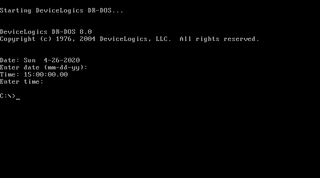 W
WDR-DOS is an operating system of the DOS family, written for IBM PC-compatible personal computers. It was originally developed by Gary A. Kildall's Digital Research and derived from Concurrent PC DOS 6.0, which was an advanced successor of CP/M-86. As ownership changed, various later versions were produced with names including Novell DOS and Caldera OpenDOS.
 W
WChibiOS/RT is a compact and fast real-time operating system supporting multiple architectures and released under a mixture of the GPL3 and Apache 2.0 licenses. It is developed by Giovanni Di Sirio.
 W
WContiki is an operating system for networked, memory-constrained systems with a focus on low-power wireless Internet of Things devices. Extant uses for Contiki include systems for street lighting, sound monitoring for smart cities, radiation monitoring, and alarms. It is open-source software released under a BSD license.
 W
WC# Open Source Managed Operating System (Cosmos) is a toolkit for building operating systems, written mostly in the programming language C# and small amounts of a high level assembly language named X#. Cosmos is a backronym, in that the acronym was chosen before the meaning. It is open-source software released under a BSD license.
DexOS is a 32-bit operating system written in x86 assembly. It is designed for coders that want direct access to all hardware, with well-commented code and documentation. It's licensed under a free to use license for commercial and non-commercial use. It is written and maintained by Craig Bamford and other voluntary developers from around the world.
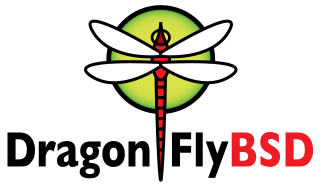 W
WDragonFly BSD is a free and open-source Unix-like operating system forked from FreeBSD 4.8. Matthew Dillon, an Amiga developer in the late 1980s and early 1990s and FreeBSD developer between 1994 and 2003, began working on DragonFly BSD in June 2003 and announced it on the FreeBSD mailing lists on 16 July 2003.
 W
WeyeOS is a web desktop following the cloud computing concept that seeks to enable collaboration and communication among users. It is mainly written in PHP, XML, and JavaScript. It is a private-cloud application platform with a web-based desktop interface. Commonly called a cloud desktop because of its unique user interface, eyeOS delivers a whole desktop from the cloud with file management, personal management information tools, collaborative tools and with the integration of the client’s applications.
 W
WFreeDOS is a free operating system for IBM PC compatible computers. It intends to provide a complete DOS-compatible environment for running legacy software and supporting embedded systems.
 W
WFreeRTOS is a real-time operating system kernel for embedded devices that has been ported to 35 microcontroller platforms. It is distributed under the MIT License.
 W
WGeckOS is an experimental operating system for MOS 6502 and compatible processors.
 W
WGenode is a free and open-source software operating system (OS) framework consisting of a microkernel abstraction layer and a set of user space components. The framework is notable as one of the few open-source operating systems not derived from a proprietary OS, such as Unix. The characteristic design philosophy is that a small trusted computing base is of primary concern in a security-oriented OS.
 W
WGhost OS is an open-source hobby operating system and kernel. It is under development since 2014 and currently compatible with the x86 platform.
 W
WGNU is an extensive collection of free software, which can be used as an operating system or can be used in parts with other operating systems. The use of the completed GNU tools led to the family of operating systems popularly known as Linux. Most of GNU is licensed under the GNU Project's own General Public License (GPL).
 W
WGNU Hurd is the multiserver microkernel written as part of GNU. It has been under development since 1990 by the GNU Project of the Free Software Foundation, designed as a replacement for the Unix kernel, and released as free software under the GNU General Public License. When the Linux kernel proved to be a viable solution, development of GNU Hurd slowed, at times having slipped intermittently between stasis and renewed activity and interest.
 W
WFuchsia is an open-source capability-based operating system currently being developed by Google. It first became known to the public when the project appeared on a self hosted form of git in August 2016 without any official announcement. The name means "Pink + Purple = Fuchsia ", which is a reference to Pink and Purple. In contrast to prior Google-developed operating systems such as Chrome OS and Android, which are based on the Linux kernel, Fuchsia is based on a new kernel called Zircon.
 W
WHaiku is a free and open-source operating system compatible with the now discontinued BeOS. Its development began in 2001, and the operating system became self-hosting in 2008. The first alpha release was made in September 2009, and the last was November 2012; the first beta was released in September 2018 and the second beta was released in June 2020.
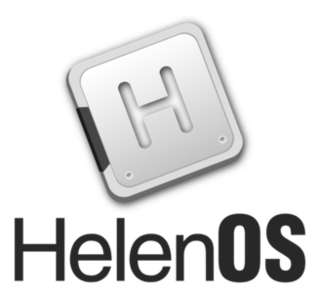 W
WHelenOS is an operating system based on a multiserver microkernel design. The source code of HelenOS is written in C and published under a BSD License.
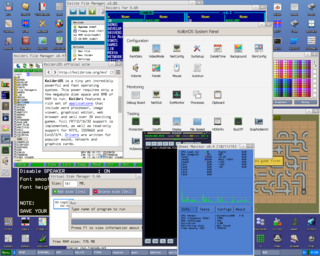 W
WKolibriOS, or Kolibri, is a small, open-source x86 operating system written completely in assembly. It was forked from MenuetOS in 2004 and has run under independent development since.
 W
WLinux Mint is a community-driven Linux distribution based on Ubuntu which itself is based on Debian, and bundled with a variety of free and open-source applications. It can provide full out-of-the-box multimedia support for those who choose to include proprietary software such as multimedia codecs.
 W
WLUnix, short for "Little Unix", is a Unix-like multi-tasking operating system designed to run natively on the Commodore 64 and Commodore 128 home computer systems. It supports TCP/IP networking. Unlike most Unix-like systems, LUnix is written in 6502 assembly language instead of C.
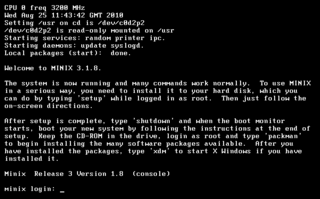 W
WMinix is a POSIX-compliant, Unix-like operating system based on a microkernel architecture.
 W
WMiNT is Now TOS (MiNT) is a free software alternative operating system kernel for the Atari ST system and its successors. It is a multi-tasking alternate to TOS and MagiC. Together with the free system components fVDI device drivers, XaAES graphical user interface widgets, and TeraDesk file manager, MiNT provides a free TOS compatible replacement OS that can multitask.
 W
WMS-DOS is an operating system for x86-based personal computers mostly developed by Microsoft. Collectively, MS-DOS, its rebranding as IBM PC DOS, and some operating systems attempting to be compatible with MS-DOS, are sometimes referred to as "DOS". MS-DOS was the main operating system for IBM PC compatible personal computers during the 1980s, from which point it was gradually superseded by operating systems offering a graphical user interface (GUI), in various generations of the graphical Microsoft Windows operating system.
 W
WMultics is an influential early time-sharing operating system based on the concept of a single-level memory. Multics "has influenced all modern operating systems since, from microcomputers to mainframes."
 W
WThe Oberon System is a modular, single-user, single-process, multitasking operating system written in the programming language of the same name. It was originally developed in the late 1980s at ETH Zürich. The Oberon System has an unconventional visual text user interface instead of a conventional CLI or GUI. This "TUI" was very innovative in its time and influenced the design of the Acme text editor for the Plan 9 from Bell Labs operating system.
 W
WDR-DOS is an operating system of the DOS family, written for IBM PC-compatible personal computers. It was originally developed by Gary A. Kildall's Digital Research and derived from Concurrent PC DOS 6.0, which was an advanced successor of CP/M-86. As ownership changed, various later versions were produced with names including Novell DOS and Caldera OpenDOS.
 W
WFreeDOS is a free operating system for IBM PC compatible computers. It intends to provide a complete DOS-compatible environment for running legacy software and supporting embedded systems.
 W
WPhantom OS is an operating system mostly made by Russian programmers. Phantom OS is based on a concept of persistent virtual memory, and is managed-code oriented. Phantom OS is one of a few OSes that are not based on classical concepts of Unix-like systems. Its primary goal is to achieve simplicity and effectiveness in both the operating system and applications at the same time.
 W
WPlan 9 from Bell Labs is a distributed operating system, originating in the Computing Science Research Center (CSRC) at Bell Labs in the mid-1980s, and building on UNIX concepts first developed there in the late 1960s. The final official release was in early 2015.
 W
WPop!_OS is a free and open-source Linux distribution, based upon Ubuntu, featuring a custom GNOME desktop. The distribution is developed by American Linux computer manufacturer System76. Pop!_OS is primarily built to be bundled with the computers built by System76, but can also be downloaded and installed on most computers.
 W
WQP is a family of lightweight, open source software frameworks for building responsive and modular real-time embedded applications as systems of cooperating, event-driven active objects (actors).
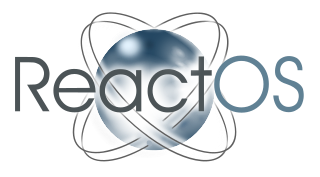 W
WReactOS is a free and open-source operating system for amd64/i686 personal computers intended to be binary-compatible with computer programs and device drivers made for Windows Server 2003 and later versions of Windows. ReactOS has been noted as a potential open-source drop-in replacement for Windows and for its information on undocumented Windows APIs.
 W
WRedox is a Unix-like microkernel operating system written in the programming language Rust, which has a strong focus on safety, stability, and high performance. Redox aims to be secure, usable, and free. Redox is inspired by prior kernels and operating systems, such as SeL4, MINIX, Plan 9, and BSD. It is similar to the GNU or BSD ecosystem, but in a memory-safe language. It is free and open-source software distributed under an MIT License.
 W
WRIOT is a small operating system for networked, memory-constrained systems with a focus on low-power wireless Internet of Things (IoT) devices. It is open-source software, released under the GNU Lesser General Public License (LGPL).
 W
WRISC OS is a computer operating system originally designed by Acorn Computers Ltd in Cambridge, England. First released in 1987, it was designed to run on the ARM chipset, which Acorn had designed concurrently for use in its new line of Archimedes personal computers. RISC OS takes its name from the reduced instruction set computer (RISC) architecture it supports.
 W
WRobot Operating System is robotics middleware. Although ROS is not an operating system, it provides services designed for a heterogeneous computer cluster such as hardware abstraction, low-level device control, implementation of commonly used functionality, message-passing between processes, and package management. Running sets of ROS-based processes are represented in a graph architecture where processing takes place in nodes that may receive, post and multiplex sensor data, control, state, planning, actuator, and other messages. Despite the importance of reactivity and low latency in robot control, ROS itself is not a real-time OS (RTOS). It is possible, however, to integrate ROS with real-time code. The lack of support for real-time systems has been addressed in the creation of ROS 2.0, a major revision of the ROS API which will take advantage of modern libraries and technologies for core ROS functionality and add support for real-time code and embedded hardware.
 W
WSerenityOS is a free and open source operating system created by Andreas Kling. It is designed to be a Unix-like operating system that draws inspiration from the graphical user interface of the 1990s. As a relatively new operating system, rapid progress is being made in its development. Its standard library includes JavaScript, graphics, audio and terminal emulation. Some of the included applications are an integrated development environment, a visual debugger, a web browser and a graphically oriented desktop shell.
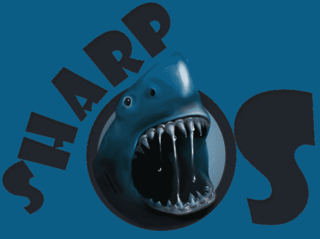 W
WSharpOS is a computer operating system based on the .NET Framework and related programming language C#. It was developed by a group of volunteers and presided over by a team of six project administrators: Mircea-Cristian Racasan, Bruce Markham, Johann MacDonagh, Sander van Rossen, Jae Hyun, and William Lahti. It is no longer in active development, and resources have been moved to the MOSA project. As of 2017, SharpOS is one of three C#-based operating systems released under a free and open-source software license. SharpOS has only one public version available and a basic command line interface.
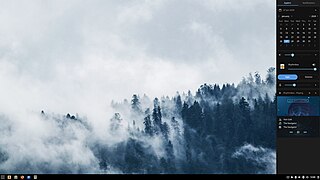 W
WSolus is an independently developed operating system for the x86-64 architecture based on the Linux kernel and a choice of the homegrown Budgie desktop environment, GNOME, MATE or KDE Plasma as the desktop environment. Its package manager, eopkg, is based on the PiSi package management system from Pardus Linux, and it has a semi-rolling release model, with new package updates landing in the stable repository every Friday. The developers of Solus have stated that Solus is intended exclusively for use on personal computers and will not include software that is only useful in enterprise or server environments.
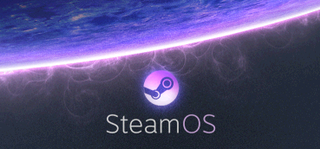 W
WSteamOS is the primary operating system for the Steam Machine gaming platform by Valve. It is based on the Debian distribution of Linux.
 W
WSyllable Desktop is a discontinued free and open-source operating system for Pentium and compatible processors. Its purpose is to create an easy-to-use desktop operating system for the home and small office user. It was forked from the stagnant AtheOS in July 2002.
 W
WTempleOS is a biblical-themed lightweight operating system designed to be the Third Temple prophesied in the Bible. It was created by the late American programmer Terry A. Davis, who developed it alone over the course of a decade after a series of prophetic episodes that he later described as a revelation from God.
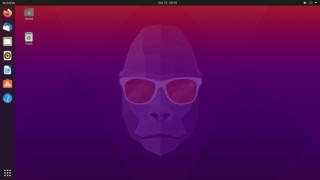 W
WUbuntu is a Linux distribution based on Debian and mostly composed of free and open-source software. Ubuntu is officially released in three editions: Desktop, Server, and Core for Internet of things devices and robots. All the editions can run on the computer alone, or in a virtual machine. Ubuntu is a popular operating system for cloud computing, with support for OpenStack. Ubuntu's default desktop has been GNOME, since version 17.10.
 W
WSixth Edition Unix, also called Version 6 Unix or just V6, was the first version of the Unix operating system to see wide release outside Bell Labs. It was released in May 1975 and, like its direct predecessor, targeted the DEC PDP-11 family of minicomputers. It was superseded by Version 7 Unix in 1978/1979, although V6 systems remained in regular operation until at least 1985.
 W
WSeventh Edition Unix, also called Version 7 Unix, Version 7 or just V7, was an important early release of the Unix operating system. V7, released in 1979, was the last Bell Laboratories release to see widespread distribution before the commercialization of Unix by AT&T Corporation in the early 1980s. V7 was originally developed for Digital Equipment Corporation's PDP-11 minicomputers and was later ported to other platforms.
 W
WWhitix is a desktop computer operating system written from scratch for the x86 architecture by Matthew Whitworth and others. The project aims to combine proven system technology, while "offering a consistent and clear interface and a new way to navigate the desktop." The operating system runs on a custom open source kernel written by Whitworth; new features include IcFs, a dynamic configuration filesystem that replaces ioctl.
 W
Wxv6 is a modern reimplementation of Sixth Edition Unix in ANSI C for multiprocessor x86 and RISC-V systems. It was created for pedagogical purposes in MIT's Operating System Engineering course.
 W
WZephyr is a small real-time operating system for connected, resource-constrained and embedded devices supporting multiple architectures and released under the Apache License 2.0. Beyond its kernel, Zephyr includes all the components and libraries needed to develop a full application such as device drivers, protocol stacks, file systems, and firmware updates.